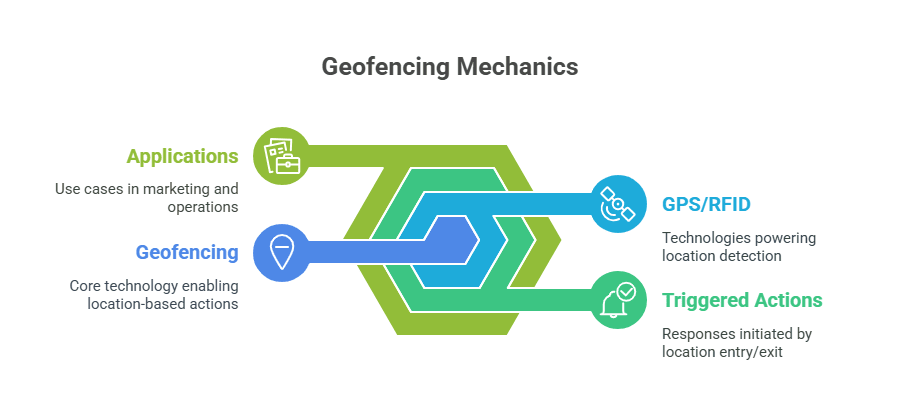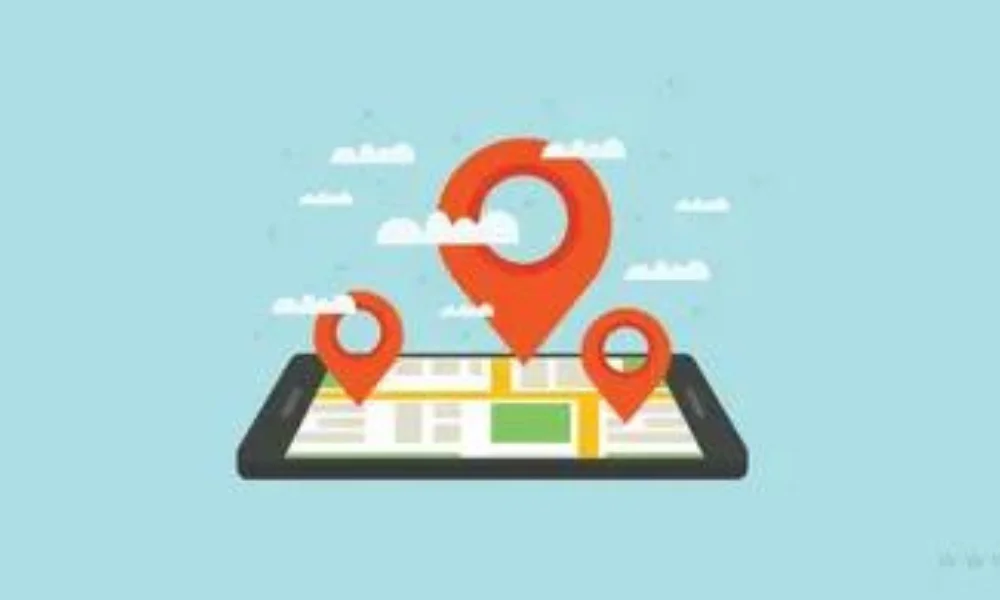Smartphones are an extension of our personality. There are in-built processes like geofencing that enable the use of location-based data to track, market, and alert administrators. If you want to harness the power of location-based marketing, then understanding what geofencing is crucial for you to take the next step.
In this article, we will be delving deeper into the aspects of geofencing and try to understand its role in marketing.
Let’s begin with clearing the basics of geofencing.

What is Geofencing? – A Detailed Overview
At its core, geofencing is a location-based service that employs a global positioning system (GPS), radio-frequency identification (RFID), Wi-Fi, or cellular data to establish a virtual boundary around a real-world geographic area.
But what is geofencing in practical terms? Imagine setting up a virtual fence around a specific location, be it a store, a city block, or an entire neighborhood. Geofencing enables businesses and individuals to trigger actions when a device enters or exits this predefined area.
Now, let’s explore how geofencing works.
How Does Geofencing Work?

Now that we have a basic understanding of what geofencing is, let’s delve into its mechanics. Geofencing relies on the GPS or RFID technology in a mobile device to trigger a pre-programmed action when it enters or exits a designated area.
This can range from sending push notifications and alerts to tracking and analyzing user behavior within the geofenced area. The versatility of geofencing makes it a valuable tool for businesses looking to enhance their marketing strategies and streamline operations.
Now that you are clear about what is geofencing technology, let’s uncover the applications of geofencing.
Applications of Geofencing:

What is the purpose of a geofencing device? Let’s break down its main functions.
1) Retail and Marketing:
- Proximity Marketing: Send personalized offers, discounts, and promotions to customers when they are near a physical store, encouraging in-store visits and purchases.
- Targeted Advertising: Advertise products or services to users within a specific geographic area, increasing the relevance of ads and conversion rates.
- Customer Engagement: Enhance customer engagement by providing real-time information and recommendations based on the user’s location and preferences.
2) Logistics and Supply Chain:
- Fleet Management: Optimize the fleet management movement of vehicles by monitoring their locations, ensuring on-time deliveries, and minimizing fuel costs.
- Route Optimization: Plan efficient delivery routes by considering real-time traffic data and customer locations, reducing delivery times and expenses.
- Cargo Tracking: Track the location of valuable shipments and receive alerts in case of unexpected route deviations or delays.
3. Security and Public Safety:
- Law Enforcement: Monitor and control specific areas during events, protests, or emergencies, ensuring the safety and security of citizens.
- Emergency Alerts: Send alerts, notifications, and evacuation instructions to residents within a geofenced area during natural disasters, accidents, or critical situations.
- Asset Protection: Protect valuable assets and equipment by setting up geofences around restricted areas, triggering alerts if unauthorized access occurs.
4. Child Safety and Family Tracking:
- Child Safety: Parents can receive alerts when their children enter or leave predefined locations, such as school, home, or extracurricular activities.
- Family Locator Apps: Use geofencing to stay connected with family members and track their whereabouts for added safety and peace of mind.
5. Employee Productivity and Workforce Management:
- Attendance Monitoring: Ensure employees are where they need to be during work hours by setting up geofences around workplaces.
- Worksite Safety: Enhance safety by implementing geofencing around hazardous areas or construction sites, triggering alerts to ensure compliance with safety protocols.
- Task Allocation: Allocate tasks to field personnel based on their proximity to specific job sites, optimizing work allocation and productivity.
6. Smart Home and IoT Integration:
- Home Automation: Use geofencing to automate tasks like turning on lights, adjusting thermostat settings, or activating security systems when residents enter or leave their homes.
- Energy Efficiency: Geofencing can help conserve energy by adjusting smart home devices based on occupancy and preferences, reducing energy consumption.
7. Sports and Events:
- Event Management: Manage large crowds at events by creating geofences, providing information, and controlling access.
- Location-Based Gaming: Augmented reality games like Pokémon Go use geofencing to create game elements in specific geographic locations.
8. Environmental Monitoring:
- Wildlife Conservation: Use geofencing to monitor and protect endangered species, triggering alerts if animals approach or leave a designated area.
- Agriculture: Geofencing can be used in precision agriculture to track crop growth, automate irrigation, and monitor equipment within a field.
Next, let’s take a look at the future scope of geofencing.
The Future of Geofencing
As technology evolves, geofencing is becoming more advanced, accurate, and accessible across industries. Here’s how the future looks:
1. Smarter with AI & ML
AI and ML will make geofencing more intelligent by:
- Delivering personalized, context-aware experiences.
- Predicting user behavior to trigger timely, relevant actions.
2. Boosted by 5G
5G will enhance geofencing by:
- Enabling faster and more precise location tracking.
- Supporting real-time responses even in high-density areas.
3. Wider Industry Applications
Beyond retail, geofencing will impact:
- Healthcare (automated alerts and check-ins)
- Logistics (fleet tracking, rerouting)
- Smart cities (home automation, traffic control)
4. Simplified Setup
Future tools will offer:
- Easy-to-use platforms with map-based geofence creation.
- Real-time analytics to track and optimize performance.
Geofencing’s future lies in smarter tech, seamless integration, and broader use, making it a key tool for businesses in the digital age.
Now, let’s try to understand the commonly asked questions about what is geofencing.
Conclusion
In conclusion, understanding what geofencing is and its multifaceted applications is crucial in today’s technology-driven world. From revolutionizing marketing strategies to enhancing security and optimizing workflows, geofencing has become an indispensable tool for businesses and individuals alike.
As we navigate the future, the question is not just “What is geofencing?” but rather, “How can we harness its potential to innovate and improve our lives?” The answer lies in embracing the power of geofencing and exploring the myriad possibilities it offers. Do you want to integrate location-based asset tracking? Look no further than Qodenext to streamline your workflows.
FAQs – What is Geofencing?
1. What is the difference between GPS and Geofencing?
Geofencing uses GPS technology as one of its components but goes beyond traditional GPS by creating virtual boundaries. While GPS tracks location, geofencing triggers actions based on a device entering or exiting a predefined area.
2. Can Geofencing Drain Device Batteries?
Geofencing does use location services, which can consume battery life. However, advancements in technology have minimized this impact. Most modern smartphones are optimized to handle geofencing efficiently without significant battery drain.
3. Can Geofencing be Hacked?
While no system is entirely immune to hacking, geofencing systems are designed with security measures to prevent unauthorized access. Regular updates and security protocols can mitigate the risk of hacking.
4. How does geofencing work with GPS?
Geofencing works with GPS (Global Positioning System) by utilizing the location-tracking capabilities of GPS-enabled devices such as smartphones.
5. What is an example of geofencing?
A retail store sets up a virtual boundary (geofence) around its location. When a customer with the store’s app enters this area, they automatically receive push notifications offering limited-time discounts, personalized product recommendations based on past purchases, or loyalty rewards. This boosts foot traffic, enhances customer experience, and increases sales through targeted, real-time marketing.
6. Does geofencing track your location?
Yes, geofencing involves tracking the location of a device within predefined virtual boundaries. When a device equipped with GPS or other location-tracking technologies enters or exits a geofenced area, the geofencing system detects the device’s location and triggers specified actions.
Also read: What is Hologram Sticker: Everything You Need to Know.







